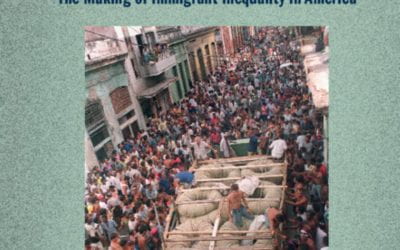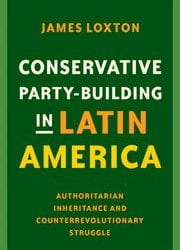Global Memorial to the Pandemic
A Place of Tribute to Life and Nature
On the afternoon of Friday, March 13, 2020, the first confirmed case of Covid-19 in Uruguay was announced. At that time, I made the decision to ask the 100 employees of Gómez Platero Arquitectura & Urbanismo not to return to the office in person on Monday. Many left that Friday without knowing that it would be months before they could return, even partially, to their workspaces. Fortunately, the technology we needed to work remotely was already in place due to our studio’s work abroad. We were able to continue providing the same service, but from our homes.
Our work went smoothly from the beginning, but I quickly began to worry about the emotional consequences that the pandemic and the ensuing changes in lifestyle could cause. Our sense of belonging and community could be affected, I fretted. The teams, used to sharing many hours daily, began to see each other a few minutes a day on Zoom during a time of unprecedented global uncertainty.
It was then that the idea arose to commission a reflective project so that the entire team of designers could work together: the design of the first large-scale memorial to the pandemic. This activity connected them in a way that far exceeded our objectives. Everyone began to design, each one sketching individually at first and then coming together to optimize the final proposal.
The result was a piece that we felt proud of, and we wanted to share it with the wider public, hoping to transform it into reality. We presented the proposal to the President of the Republic, Luis Lacalle Pou, who was very enthusiastic. That same day he made the project public in all prime-time news programs.



From that moment on, the impact and global coverage of our memorial skyrocketed exponentially, with a force that we did not imagine. I am sure that reflects the imperative need at a collective level to have a space to reflect on what we experienced in this last period. Several media, including The New York Times, The Washington Post, ArchDaily, Dezeen and National Geographic, wrote about the proposed memorial. In addition, a feature about the Memorial was selected by Stir World, an international magazine for architecture, design and art, as one of the top 10 most-read articles of 2020.
We’re also proud that we have been recognized by the International Architecture Award in the monuments category, awarded by the Chicago Athenaeum, a collective made up of the Museum of Architecture and Design and the European Center for Architecture, Art, Design and Urban Studies.
Private companies interested in financing the memorial space quickly emerged. We already have the president’s expressed support and the approval of the Uruguayan Commission of Cultural Heritage of the Nation. We are on our path to gaining several other approvals from different public institutions.

A new way of seeing the world
The global impact of this pandemic has revealed to us a new world map. This project is based on three clear findings:
—The understanding of an extended, continuous and expansive Nature, which spreads its domain symmetrically towards the micro and the macro as human knowledge imagines, investigates and explores. Between the colonization of interplanetary space and the decoding of the human genome, humanity consolidates the idea that we are only one part of an expanded ecosystem. We share with other organisms a habitat that sustains life, where nature is undoubtedly the protagonist.
—Human behavior on a global scale has been decisive. The impact on individual behavior and the new collective habits of responsible coexistence makes evident how our vulnerable individual reality depends on the behavior of others and vice-versa.
—Instant access to global information, sustained by technological disruption, has dissolved the boundaries between the physical world and the digital world, hybridizing their nature. While the first, spatial and multidimensional, has been reduced and emptied, isolating us from what is near us; the digital, two-dimensional and abstract, has expanded and intensified, bringing us closer and connecting us to what is far.
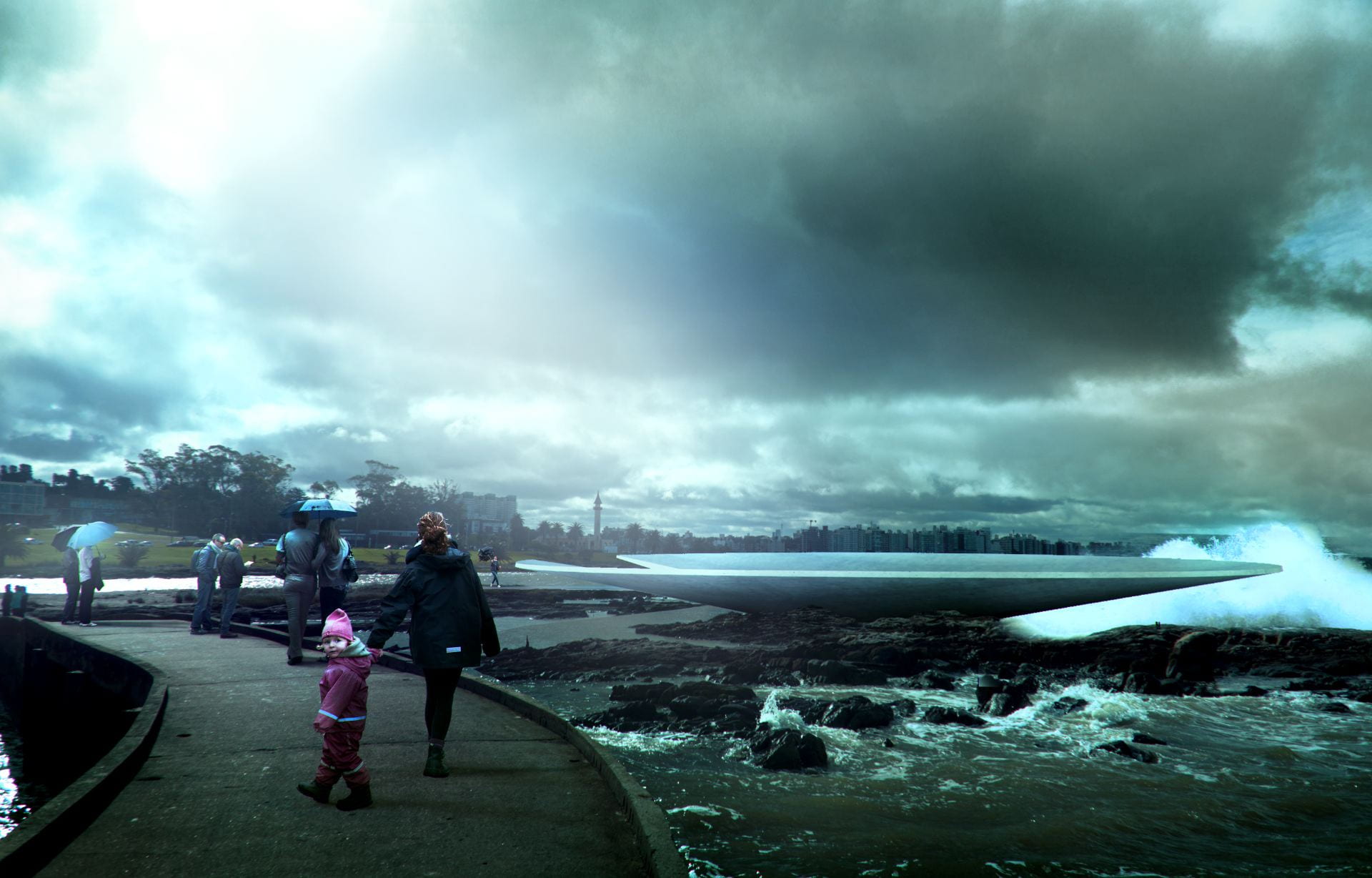

I am convinced that this unfolding— transitory in relation to the world’s biological state—will reinforce a future in which human interaction as a vital purpose will be amplified and reinforced in a complementary and integrated nature.
The new reality has conditioned our ways of life, our customs and the way we relate. In the midst of this process, all activities and disciplines of knowledge—amidst innumerable uncertainties—are being repositioned to provide answers to this new crisis.
From the vantage of architecture, we assume the commitment to think and build a physical reference.
A public space testifies to this particular collective conjuncture: a Global Memorial to the Pandemic.
The project is an analog artifact, with a tectonic body, that exists on the hybrid border between object and habitable space, between monument and public space. A device capable of activating the senses and recreating bridges between the memorial and individual memory. Our memorial should provide a transformative image of the world that reminds us in a clear and forceful way of human subordination to nature.
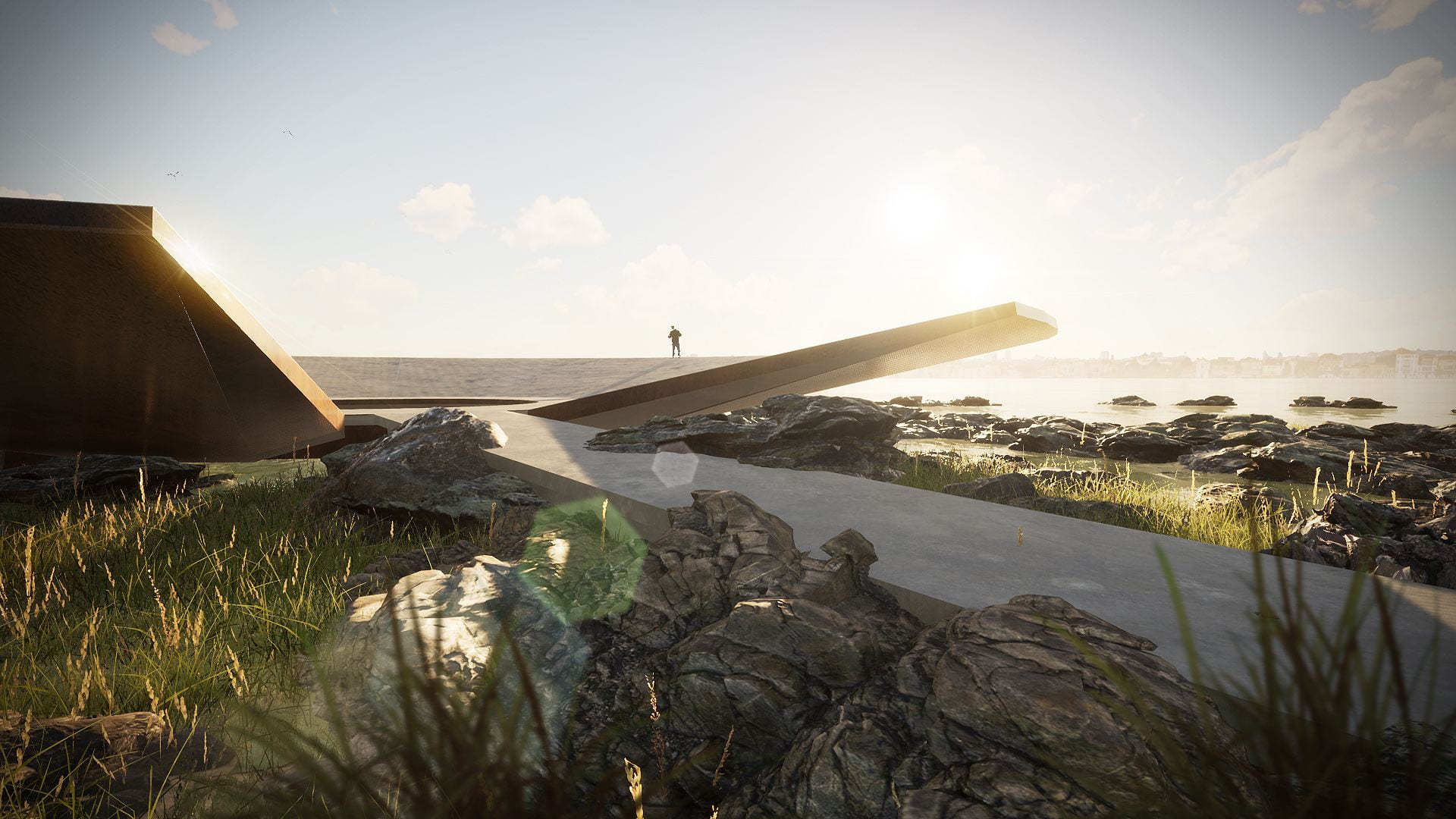

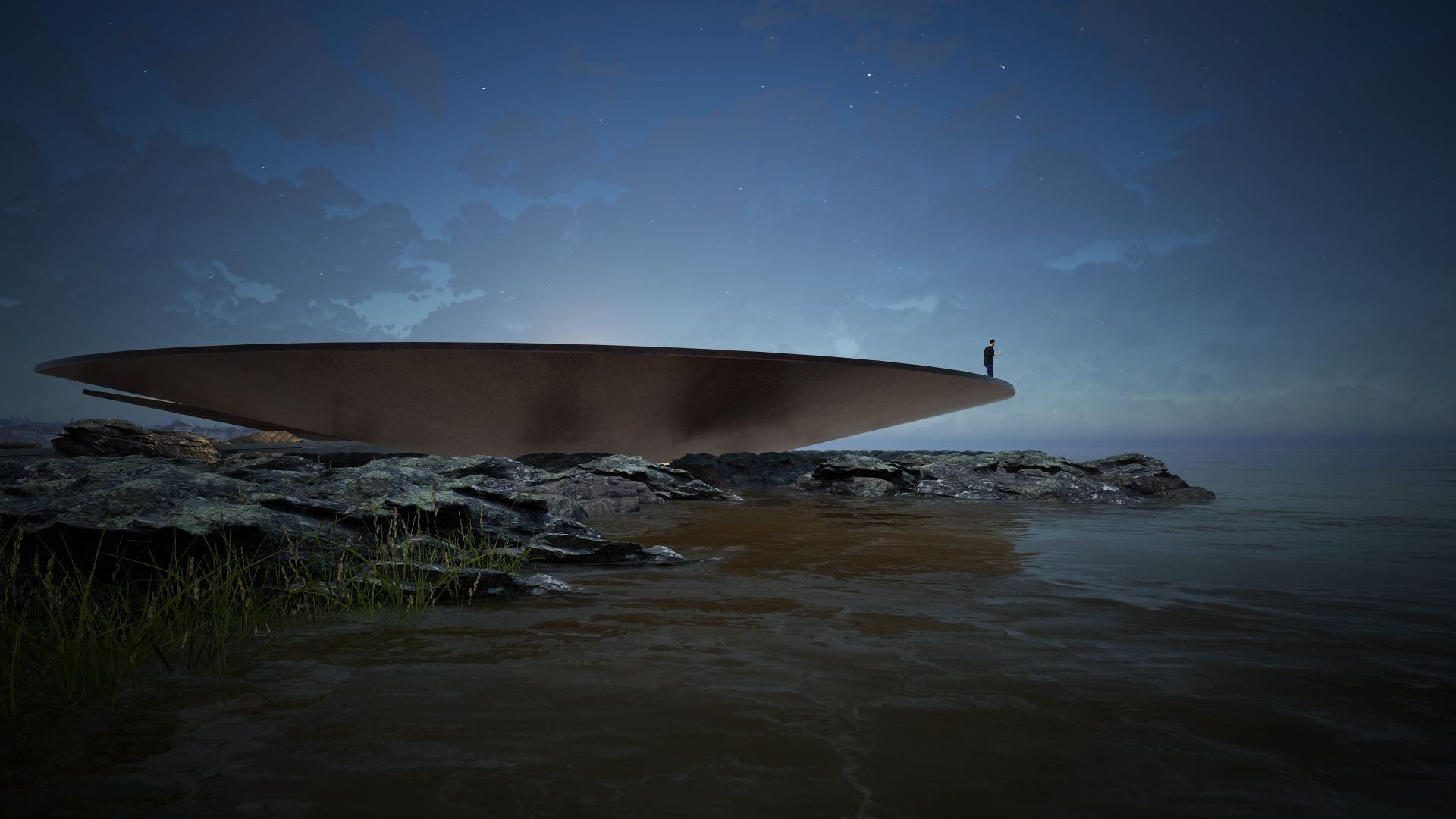
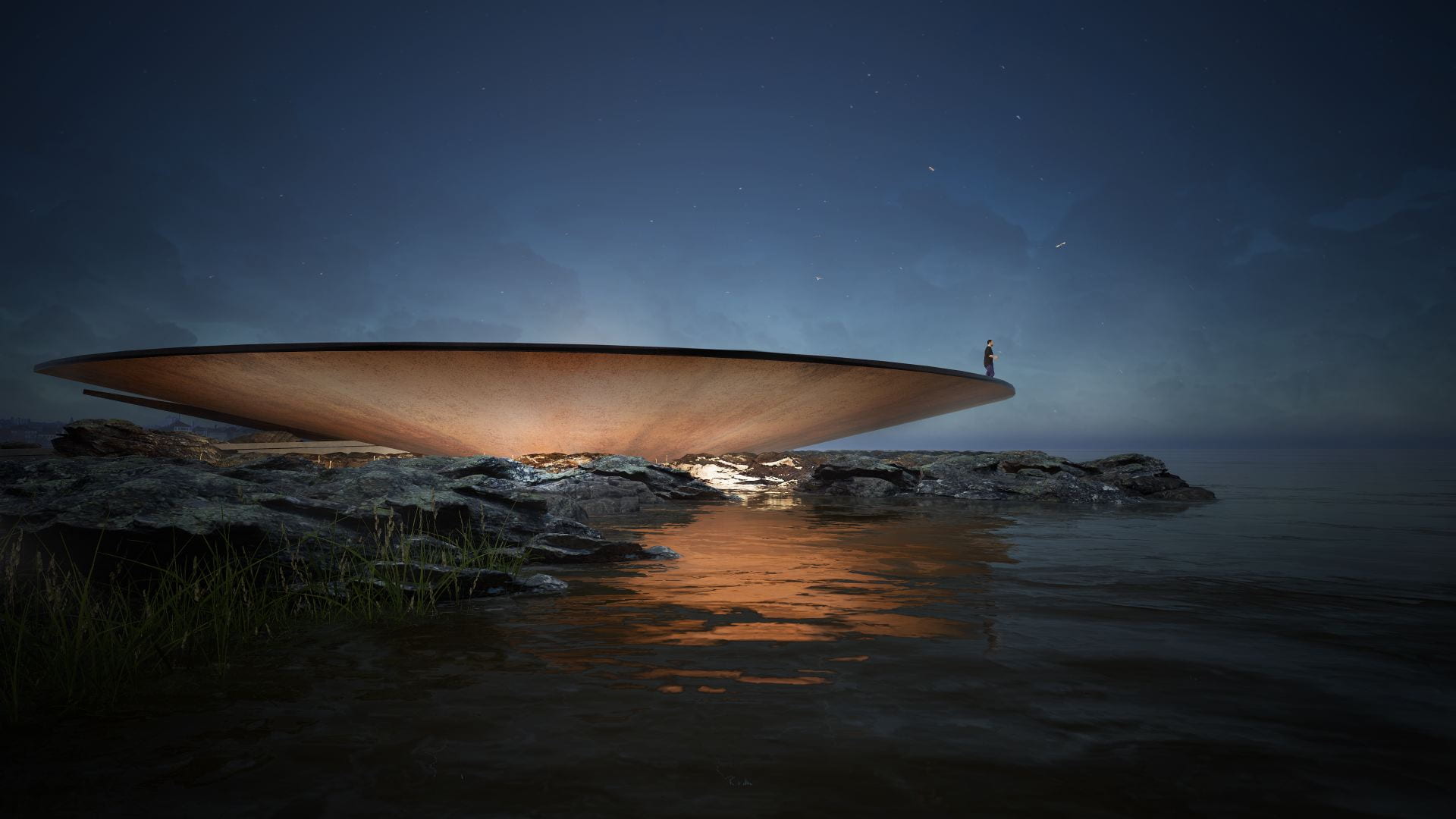
Between land and sea
The monument will be located on a physical edge strongly conditioned by the natural world, a border between the built terrain and nature, between the coastal edge and the sea, between the local and the global.
If the built city represents the dominion of man over primeval nature, the edge of the sea is understood as a dialectical border between the transformable and the non-malleable. It is the place where the “conditioned” territory, known and stable, of the urban meets the indeterminate and dynamic of the natural liquid body. Perhaps there lies its strange fascination, understood beyond the seductive visual landscape that represents it.

Walking towards the edge, where nature and artifice meet, is a progressive departure from the determined, planned and safe to the ephemeral, indomitable and unknown. It is an environment of vulnerability and growing uncertainty.
The absence of human references and the imposing scale of the maritime landscape dramatize this experience. This selective distancing from our particular reality, by contrast, also brings us closer to a common, less specific, more global and shared natural reality: there, beyond the edge, is the world.

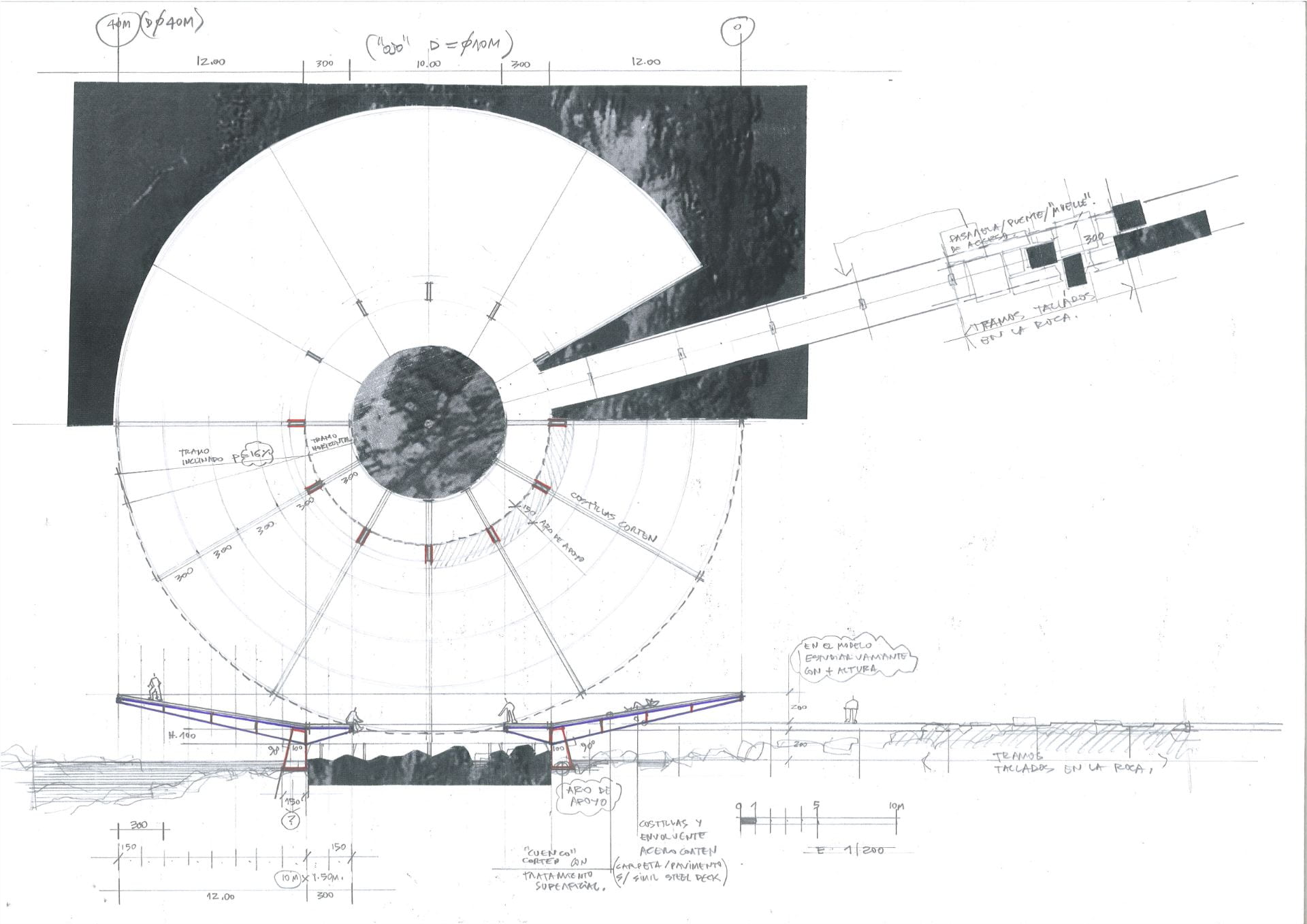
A New Public Space for the City
Inspired by the present, but thought as a contribution to the future, the World Memorial to the Pandemic is a project which will generate public space without impact on the environment or cost to the state. It is a public space oriented toward reflection that, although it arises from the experience of the pandemic, is not limited to it or to the way in which the planet and human beings face such a crisis. On the contrary, it aims to continue building a collective consciousness that reminds us that we are not the center of the ecosystem in which we live; we are always subordinate to nature. Understanding and interpreting our relationship with nature and its dynamism will be a permanent reminder of our place in the world.
The Memorial will be an object with a simple and forceful shape, a basic human action on the place, a concave space that when exposed disappears due to changing climatic conditions, merging with the horizon. The simplicity of its form, created in a single and precise stroke, reinforces its silent and timeless expressive power. Supported on the site in a respectful way and with minimal environmental impact, it immerses itself in its environment.
The space’s circular geometry and concavity are only interrupted by a crack that provides entrance to the monument; it is a break and rupture that reminds us of a singular event, a global event. The threshold will be a fracture in the continuity of form and senses, precisely demarcating the interior and exterior, confronting nature and artifice.
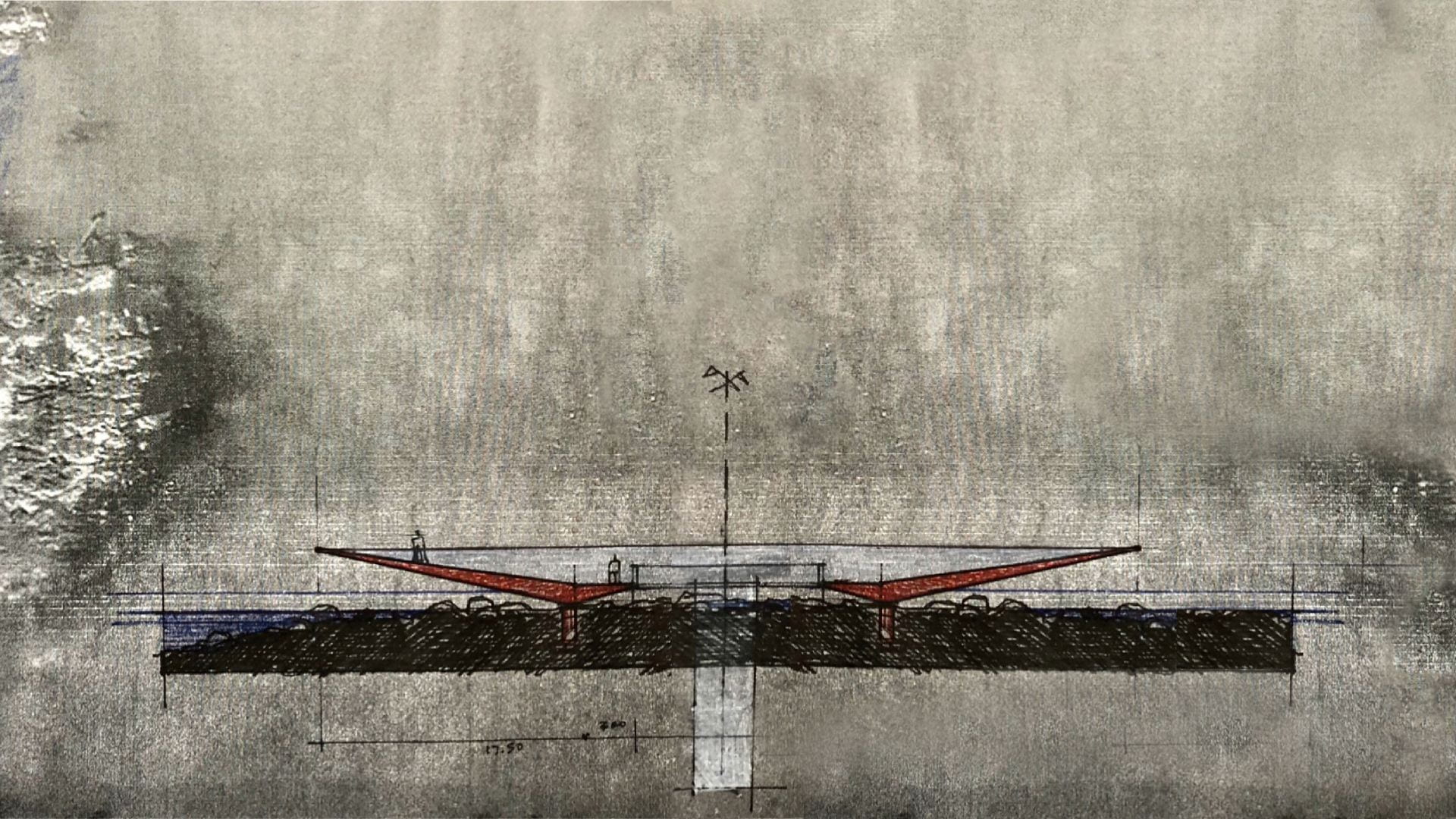
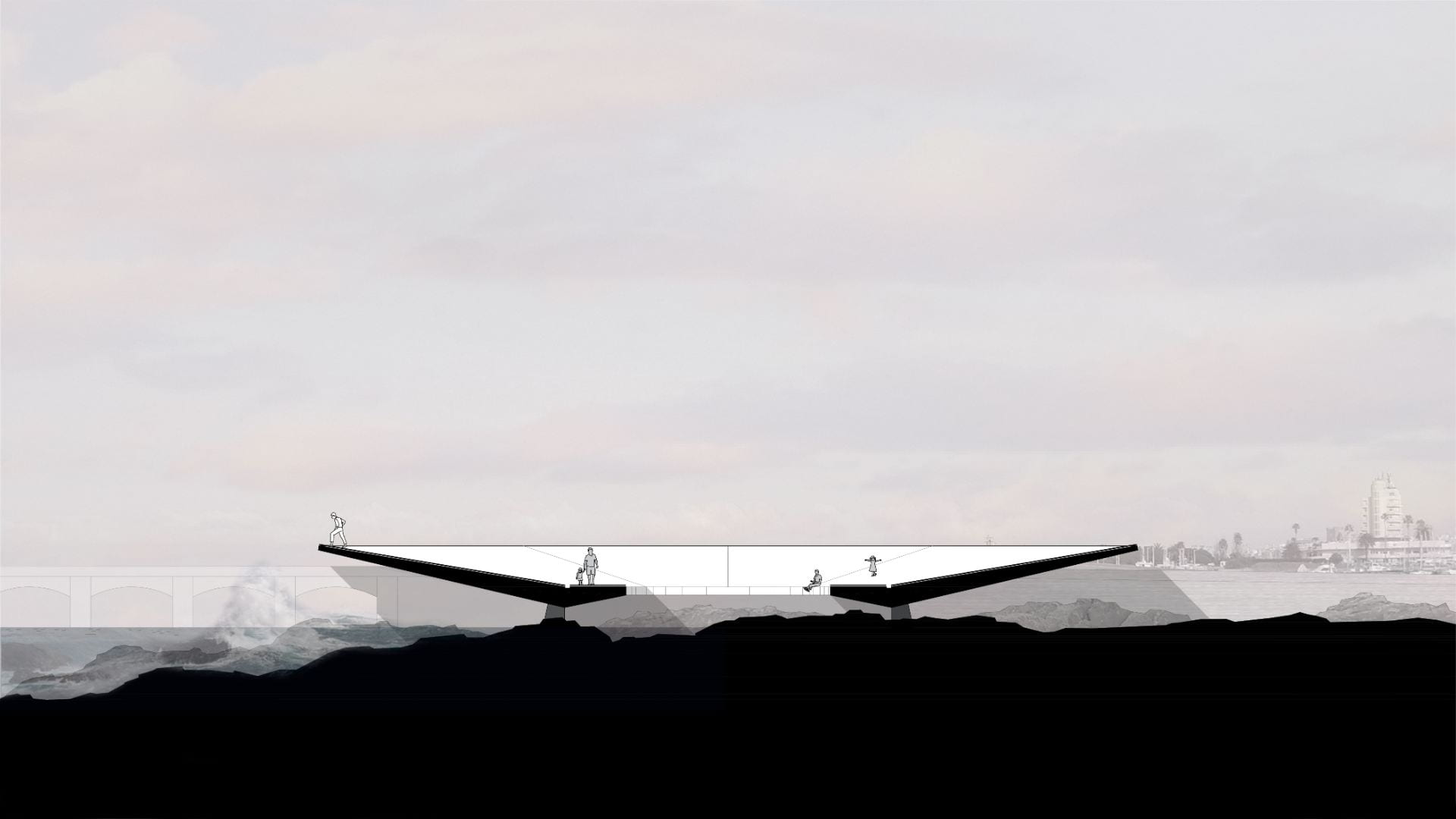
Nature at the Center
The center of the space is occupied by a void where nature flowers in its pure state, reminding us of its omnipresence and our fragile condition.
We propose a multisensory space in which perceptions will build a universe of senses and associations, supported by the contrast between the refined materiality of the object and the rough texture of the place. From the inside, the concavity of the form mesmerizes us, emphasizing the power of the natural environment and the horizon. The sky and the center build an imaginary vertical connection that reveals and returns a resignified fragment of nature.
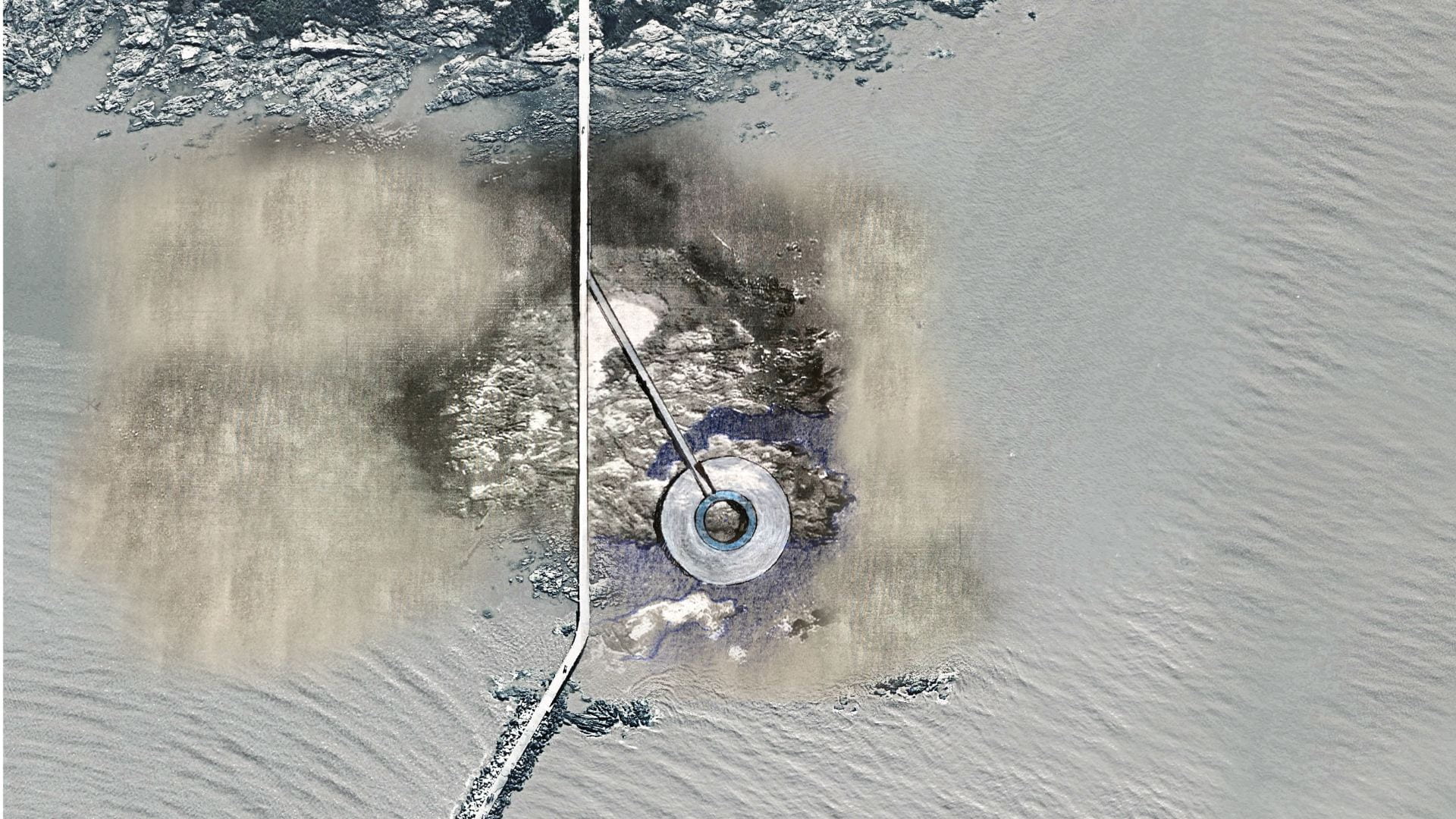
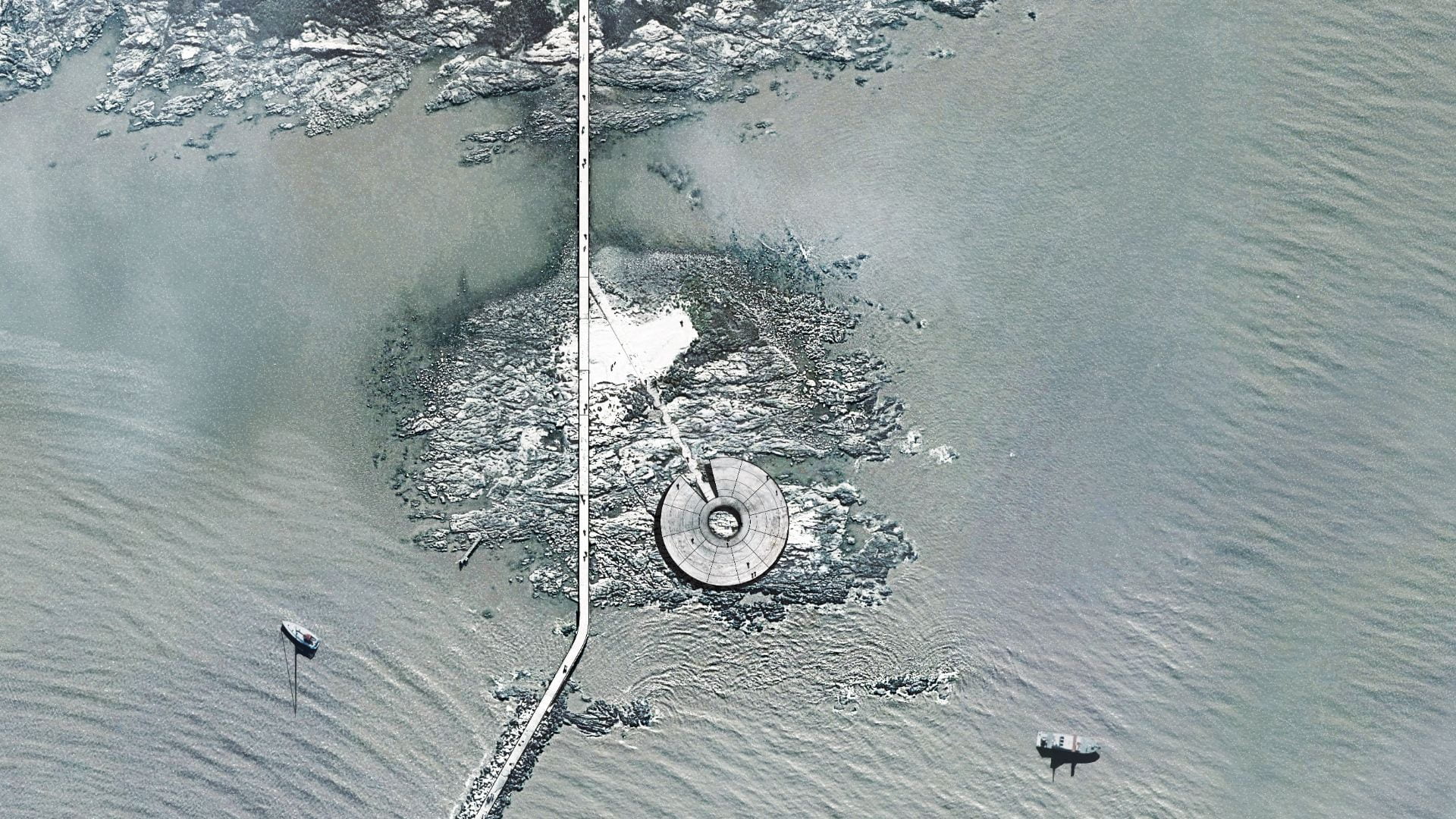
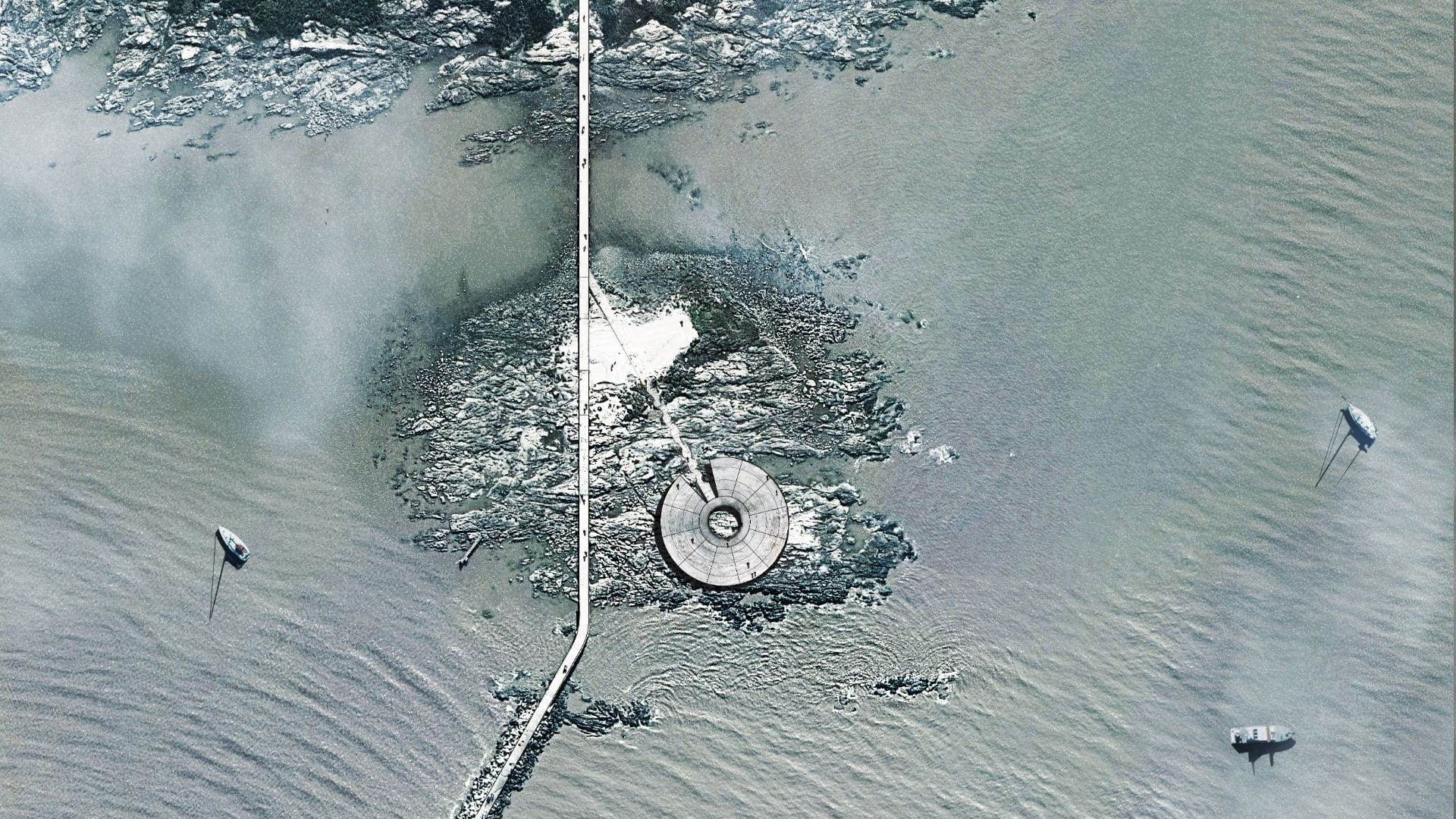
The immersive experience in the proposed space seeks to build an atmosphere that amplifies the senses, an instrument of evocation. It was intended as a space for reflection, an expansion of the public space that inaugurates a new place for exploration. It will adopt the various uses that the collective assigns to it.
The route starts with the urban landscape and makes its way to the sea. A new and minimally invasive path, carved on the rock, takes us away from the urban environment to find the calm of the contained space. The gaze goes from recognizing the visual singularity of its profile cut out on the horizon, to appreciating it as a spatial basin that amplifies the sound of the sea.
The circular form summarizes concepts of unity and community. It materializes as a concave sheet with which the architecture fixes a precise reference. That reference reveals the constant variation of the natural landscape, a measurement of the force of the sea, a place of shelter and exposure to the wind.
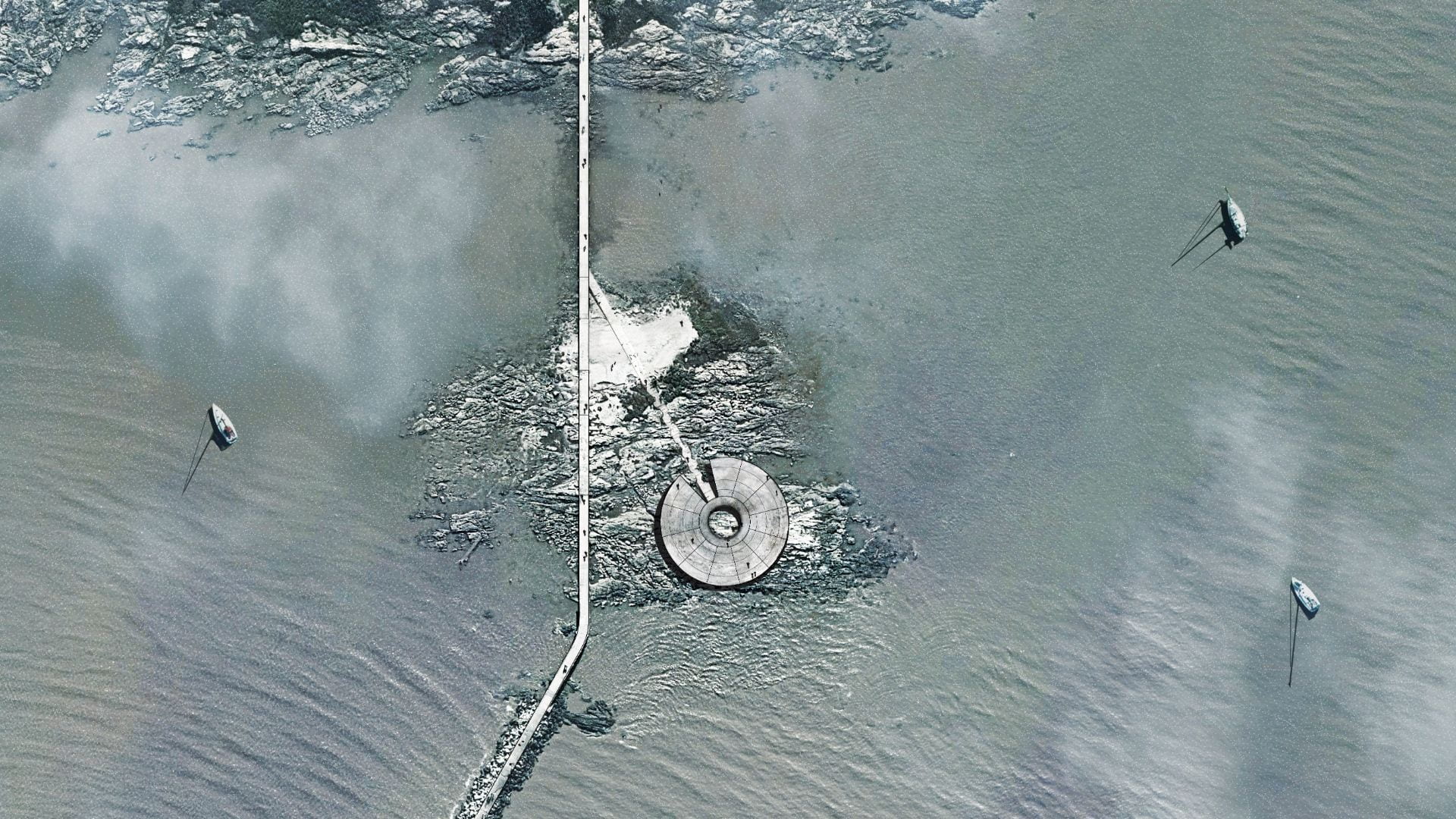


The central void focuses on a fragment of natural territory and then randomly unfolds on the slightly inclined surface until it reaches the upper edge that brings back the distant horizon.
The form reacts to the climate, adapting to multiple uses and users. It is a stage for celebrating our social reencounter and life, where people can be protagonists and spectators of countless undetermined events.
Concrete and weathering steel are highly resistant to climatic exposure; they bear witness through oxidation and wear to the passage of time. Choosing these materials for the project allows the memorial to go beyond its immediate qualities. There will be a sense of change in their experience due to climate’s effects. Stage lighting will be part of this visual dynamic to co-construct infinite landscapes alongside nature.
The object’s dynamic experience intensely connects the visitor with her perception of time and place. It builds a space that stimulates the creation of sensory atmospheres where the alternation of sounds and silences allow us to reflect, listen to ourselves and imagine an encouraging shared future: making the Earth the best place to live.


Memorial mundial a la pandemia
Un espacio homenaje a la vida y la naturaleza
Por Martín Gómez Platero
La tarde del viernes 13 de marzo de 2020 se anunció el primer caso confirmado de Covid 19 en Uruguay. En ese momento tomé la decisión de pedir a los 100 empleados de Gómez Platero Arquitectura & Urbanismo que el lunes no retornaran a la oficina de forma presencial. Muchos se retiraron ese viernes sin saber que pasarían meses antes de poder volver, aunque fuera de forma parcial, a sus espacios de trabajo. Por suerte la tecnología que necesitábamos para trabajar a distancia ya estaba implementada debido a los vínculos laborales de nuestro estudio con el exterior y pudimos seguir brindando el mismo servicio, pero desde nuestras casas.
Por ese lado las cosas funcionaron bien desde el principio, pero rápidamente comenzaron a preocuparme las consecuencias anímicas que la pandemia, y los cambios de forma de vida que implicó, pudieran provocar. El sentido de pertenencia grupal podía haber sido afectado, pensé. Los equipos, acostumbrados a compartir muchas horas diariamente, pasaron a verse unos pocos minutos al día en Zoom en medio de un contexto global de incertidumbre sin precedentes.



Fue entonces que surgió la idea de encargar un ejercicio de reflexión para que todo el equipo de proyectistas pudiera trabajar en conjunto: el diseño del primer memorial a gran escala a la pandemia. Esta actividad los conectó de una forma que superó ampliamente los objetivos del ejercicio. Todos se pusieron a diseñar, primero cada uno bocetando por su lado y luego en conjunto para optimizar la propuesta elegida como finalista.
El resultado fue una pieza de la que nos sentimos orgullosos y que quisimos compartir y transformar en realidad. Fue así que se la presentamos al Presidente de la República, Luis Lacalle Pou, quien se entusiasmó mucho con la propuesta y ese mismo día la hizo pública en todos los programas informativos de horario central.
A partir de ese momento la repercusión y cobertura periodística global del proyecto se disparó exponencialmente, con una fuerza que no imaginábamos y que estoy seguro refleja la necesidad imperiosa que existe a nivel colectivo de tener un espacio para reflexionar sobre lo vivido en este último período. Varios medios, incluyendo The New York Times, The Washington Post, ArchDaily, Dezeen y National Geographic, publicaron reportajes sobre la propuesta. Además, un artículo sobre el Memorial fue seleccionado por la revista internacional de arquitectura, diseño y arte, Stir World, como una de las 10 mejores lecturas del año 2020.


También, estamos orgullosos del reconocimiento del Premio Internacional de Arquitectura en la categoría monumentos, otorgado por el Ateneo de Chicago, un colectivo integrado por el Museo de Arquitectura y Diseño y el Centro Europeo de Arquitectura, Arte, Diseño y Estudios Urbanos.
Rápidamente surgieron empresas privadas interesadas en financiar este espacio, cuya construcción hoy cuenta con el apoyo expreso del presidente de la República, con la aprobación de la Comisión de Patrimonio Cultural de la Nación y continúa su camino de aprobaciones en las diferentes instituciones públicas involucradas.



Una nueva forma de ver el mundo
El impacto global de esta pandemia nos ha revelado un nuevo mapa del mundo. Este proyecto se apoya en tres constataciones claras:
—El entendimiento de una Naturaleza extendida, continua y expansiva, que extiende su dominio de forma simétrica hacia lo micro y lo macro en tanto el conocimiento humano imagina, indaga y explora. Entre la colonización del espacio interplanetario y la decodificación del genoma humano, la humanidad consolida la idea de que solo somos una parte de un ecosistema ampliado que comparte, con otros organismos, el mismo hábitat que sostiene la vida, donde la naturaleza sin duda es la protagonista del ecosistema.
—El comportamiento humano analógico a escala global ha sido determinante. El impacto en la conducta individual y los nuevos hábitos colectivos de convivencia responsable, expresan de forma elocuente que nuestra vulnerable realidad individual depende del comportamiento de otros y viceversa.
—El acceso instantáneo a la información global, sostenido por la disrupción tecnológica, ha disuelto las fronteras entre el mundo físico y el mundo digital, hibridando su naturaleza. Mientras el primero, espacial y multidimensional, se ha reducido y vaciado, aislándonos de lo cercano; el digital, bidimensional y abstracto, se ha ampliado e intensificado, acercando y conectando lo lejano.
Estoy convencido de que este desdoblamiento escénico, transitorio a propósito de la coyuntura biológica, reforzará un futuro de naturaleza complementaria e integrada para sostener y amplificar la interacción humana como propósito vital


La nueva realidad ha condicionado nuestros modos de vida, costumbres y la forma en que nos relacionamos. En pleno tránsito de este proceso son innumerables las incertidumbres que se abren de cara al futuro. Todas las actividades y disciplinas del conocimiento se están reposicionando para dar respuestas a esta nueva crisis.
Desde la arquitectura asumimos el compromiso de pensar y construir una referencia física.
Un espacio público testimonio de esta particular coyuntura colectiva: un Memorial Mundial a la Pandemia.
El proyecto es un artefacto analógico, de cuerpo tectónico, que existe en la frontera híbrida entre objeto y espacio habitable, entre monumento y espacio público. Un dispositivo capaz de activar los sentidos y recrear puentes entre la experiencia del lugar y la memoria individual, que nos devuelva una imagen del mundo transformadora que nos recuerde de forma clara y contundente la subordinación del ser humano a la naturaleza

Entre la tierra y el mar
La intervención se proyecta en un espacio localizado sobre un borde físico fuertemente condicionado por lo natural, frontera entre el territorio construido y la naturaleza, entre el borde costero y el mar, entre lo local y lo global.
Si la ciudad construida representa el dominio del hombre sobre la naturaleza primigenia, el borde del mar se entiende como una frontera dialéctica entre lo transformable y lo no asible. Es el lugar donde el territorio “acondicionado”, conocido y estable, de lo urbano se encuentra con lo indeterminado, dinámico y mutante del territorio líquido natural. Quizás allí radique su extraña fascinación, entendida más allá del seductor paisaje visual que lo representa.


Caminar hacia el borde, donde naturaleza y artificio se encuentran, es un apartamiento progresivo desde lo determinado, planificado y seguro hacia lo efímero, indomable y desconocido, un entorno de vulnerabilidad e incertidumbre creciente.
La ausencia de referencias humanas y la escala imponente del paisaje marítimo dramatizan esta experiencia. Este distanciamiento selectivo de nuestra realidad particular, en contrapartida también nos acerca a una realidad natural común, menos específica, más global y compartida: allá está el mundo.


Un nuevo espacio público para la ciudad
Inspirado por la actualidad, pero pensado como una contribución al futuro, el Memorial Mundial a la Pandemia es un proyecto de generación de espacio público sin impacto para el medio ambiente ni costo para el Estado. Es un espacio público orientado a la reflexión que, si bien surge por la experiencia de esta pandemia, no se limita a ella ni a la forma en que el planeta y los seres humanos la enfrentamos. Por el contrario, tiene como objeto seguir construyendo una conciencia colectiva que nos recuerde que no somos el centro del ecosistema en que vivimos ya que siempre estamos subordinados a la naturaleza. Comprender e interpretar nuestra relación con la naturaleza dinámica será un recordatorio permanente de nuestro lugar en el mundo.



El Memorial será un objeto de forma simple y contundente, una acción humana primaria sobre el lugar, un espacio cóncavo que al exponerse desaparece producto de las cambiantes condiciones climáticas, fundiéndose con el horizonte. La simplicidad de su forma, creada en un único y preciso trazo, refuerza su silenciosa y atemporal potencia expresiva. Apoyado sobre el sitio de forma respetuosa y con mínimo impacto medioambiental, se sumerge en la naturaleza del lugar.
La geometría circular y la concavidad del espacio solo se interrumpen en la grieta que da ingreso al lugar, quiebre y ruptura que nos recuerda un evento singular, un suceso global. El umbral será una fractura en la continuidad de la forma y en lo sensorial, demarcando con precisión el interior y el exterior, confrontando naturaleza y artificio.



La naturaleza como centro
El ojo de este espacio lo ocupa un vacío en donde aflora la naturaleza en estado puro, lo que nos recuerda su omnipresencia y nuestra frágil condición.
Se propone un espacio multisensorial en el que las percepciones construirán un universo de sentidos y asociaciones, apoyadas en el contraste entre la materialidad depurada del objeto y la textura rugosa del lugar. Desde el interior la concavidad de la forma nos retiene, velando la potencia del entorno natural y el horizonte. El cielo y el ojo central, construyen una imaginaria conexión vertical que nos revela y devuelve un fragmento resignificado de la naturaleza.
La experiencia de inmersión en el espacio propuesto procura construir una atmósfera que amplifica los sentidos, un instrumento de evocación. Fue pensado como un espacio de reflexión, una dilatación del espacio público que funda un nuevo espacio a explorar, que adoptará los diversos usos que el colectivo le asigne.
El recorrido de aproximación parte desde lo urbano adentrándose en el mar. Una mínima acción de proyecto incorpora un nuevo camino que, tallado sobre la roca del lugar, nos aparta del ambiente urbano para encontrar la calma del espacio contenido. La mirada pasa de reconocer la singularidad visual de su perfil recortado en el horizonte, a apreciarlo como un cuenco espacial que amplifica el sonido del mar.
La forma circular resume el concepto de unidad y comunidad. Se materializa como una lámina cóncava con la que la arquitectura fija una referencia precisa que revela la constante variación del paisaje natural, una escala de medida de la fuerza del mar, un lugar de abrigo y exposición al viento.


El vacío central enfoca un fragmento de territorio natural para luego desdoblarse aleatoriamente sobre la superficie levemente inclinada hasta conquistar el borde superior que nos devuelve el horizonte lejano.
La forma reacciona frente el clima, adaptándose a múltiples usos y usuarios, es un escenario donde celebrar el reencuentro social y la vida, donde las personas podrán ser protagonistas y espectadores de infinidad de eventos no determinados.
El hormigón y el acero-corten son materiales de alta resistencia a la exposición climática, que se apropian del desgaste y la oxidación como testigos del paso del tiempo. Con su elección el proyecto propone ir más allá de sus cualidades dado el sentido de experiencia cambiante que los visitantes obtendrán de ellos por efecto de la acción climática.
La iluminación escénica será parte de esta dinámica visual para co-construir infinitos paisajes de la mano de la naturaleza.
La experiencia dinámica del objeto conecta intensamente al visitante con su percepción del tiempo y el lugar. Construye un espacio que estimula la creación de atmósferas sensoriales en donde la alternancia de los sonidos y los silencios del lugar nos permiten reflexionar, escuchar nuestro interior e imaginar un futuro compartido alentador: haciendo de la Tierra el mejor lugar para vivir.
Martín Gómez Platero is the director of Gómez Platero Architecture & Urbanism, a global architecture and urban planning firm with headquarters in Uruguay and offices in Ecuador and Mexico. Gómez Platero has completed projects in more than thirty cities in eleven Latin American countries.
Martín Gómez Platero es director y fundador de Gómez Platero Arquitectura & Urbanismo, firma global de arquitectura y urbanismo con sede en Uruguay y oficinas en Ecuador y México. Gómez Platero ha realizado proyectos en más de treinta ciudades en once países de América Latina. Se recibió de Arquitecto en la Universidad de la República y realizó un postgrado en Business Administration en la Universidad de California, Berkeley.
Gómez Platero Arquitectura y Urbanismo: Página web, Instagram, LinkedIn
Related Articles
A Review of Cuban Privilege: the Making of Immigrant Inequality in America by Susan Eckstein
If anyone had any doubts that Cubans were treated exceptionally well by the United States immigration and welfare authorities, relative to other immigrant groups and even relative to …
A Review of Conservative Party-Building in Latin America: Authoritarian Inheritance and Counterrevolutionary Struggle
James Loxton’s Conservative Party-Building in Latin America: Authoritarian Inheritance and Counterrevolutionary Struggle makes very important, original contributions to the study of…
Endnote – Eyes on COVID-19
Endnote A Continuing SagaIt’s not over yet. Covid (we’ll drop the -19 going forward) is still causing deaths and serious illness in Latin America and the Caribbean, as elsewhere. One out of every four Covid deaths in the world has taken place in Latin America,...

